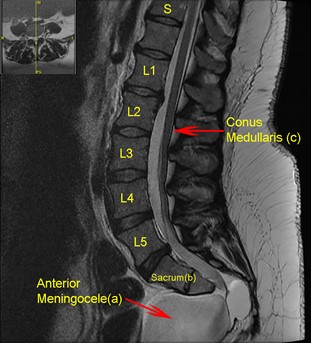Rare: 1 to 10/100,000. Autosomal dominant transmission with low penetrance (and low incidence of de novo mutations) of a mutation of the MNX1 gene (formerly known as HLXB9) (7q36.3). Female predominance. Particular form of caudal regression syndrome associating a congenital triple malformation:
- partial sacral agenesis: typically, scimitar picture on the AP X-ray of the sacrum (88 %)
- anorectal malformation of varying severity (malposition, stenosis, imperforation)
- the presence of a presacral mass: anterior lipomeningocele, dermoid or epidermoid cyst (teratoma), rectal duplication.
It is sometimes associated with a malformation of the spinal cord (70 %) (tethered cord, thick filum: a Chiari malformation with a risk of cerebellar herniation can be present), Hirschsprung's disease or trisomy 21. Bladder disorders are common. In case of minimal anorectal malformation (anterior displaced anus, for example), the first signs are usually constipation, surinfection of the presacral mass or meningitis. The diagnosis is often late, even in adulthood.

Treatment: correction of the anorectal malformation and of the tethered cord if it is present. The treatment of the presacral mass depends on its size and its nature.
Anesthetic implications:
echography as before any correction of an anorectal malformation if an regional analgesia technique is planned. MRI of the pelvis and brain. Risk of dural leak (communication between the presacral mass and the dural sac). Problems of rectovesical innervation. A few ultrasound-guided locoregional neuraxial blocks have been reported according to the results of preoperative MRI, with unexpected extension of the blocked area. Exclude a Chiari malformation.
References :
- Martuciello G, Torre M, Belloni E, Lerone M, Pini Prato A, Jasonni V.
Currarino syndrome : proposal of a diagnostic and therapeutic tool.
J Pediatr Surg 2004; 1305-11.
- AbouZeid AA, Mohammad SA, Abolfotoh M, Radwan AB et al.
The Currarino triad: what pediatric surgeons need to know.
J Pediatr Surg 2017; 52: 1260-8.
- Kenevan MR, Smith HM, Olsen DA, Sharpe EE.
Ultrasound-guided combined spinal-epidural anesthesia for cesarean delivery in a parturient with Currarino triad: a case report.
A&A Practice 2019; 12: 393-5.
- Neumann KE, Pappas H, McCrory EH.
Peripartum diagnosis of Currarino syndrome with anterior meningocele: a case report.
A&A Practice 2021; 15: e01506
Updated: October 2021